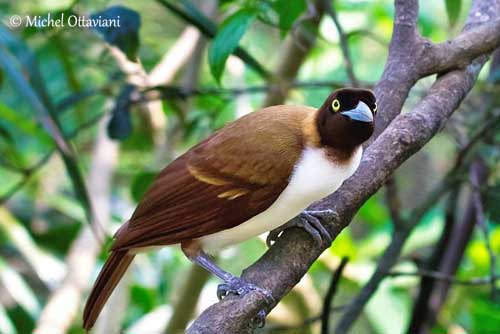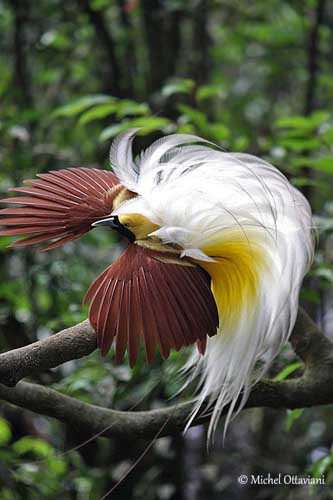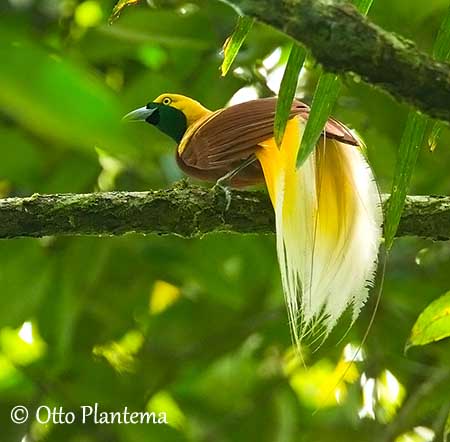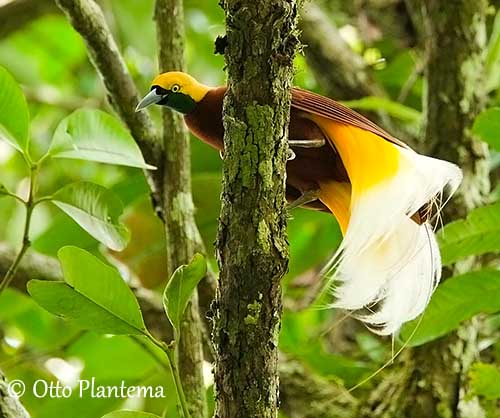
FLIGHT:
The Lesser Bird-of-paradise performs undulating and floppy flight.
REPRODUCTION:
The breeding season occurs between July and February. The female builds the nest, a bulky cup made with twigs and sticks, vines and dead leaves. The interior is lined with black vegetal fibres and rootlets. The nest is placed in tree fork, and relatively high, six metres and more above the ground.
The female lays 1-2 pinkish eggs with dark markings. The incubation lasts about 18-20 days. The young leave the nest 18-19 days after hatching. The female performs all the nesting duties alone.
DIET:
The Lesser Bird-of-paradise feeds mainly on fruit and arthropods.
PROTECTION / THREATS / STATUS:
This species is reported to be common and widespread in spite of pet trade and hunting for feathers by local people, and the threatened tropical rainforest.
However, the Lesser Bird-of-paradise is not currently threatened.
Fr: Paradisier petit-émeraude
All : Kleiner Paradiesvogel
Esp: Ave-del-paraíso Esmeralda Chica
Ital : Uccello del Paradiso minore
Nd: Kleine Paradijsvogel
Sd: Liten paradisfågel
Photographer:
Michel Ottaviani
Le site de Michel Ottaviani
Otto Plantema
Trips around the world
Text by Nicole Bouglouan
Sources:
HANDBOOK OF THE BIRDS OF THE WORLD Vol 14 by Josep del Hoyo-Andrew Elliot-David Christie - Lynx Edicions – ISBN: 9788496553507
Les Oiseaux de paradis – Histoire Naturelle et photographies - par Michel Ottaviani - Editions Prin, France – ISBN : 2-909136-40-X
BirdLife International (BirdLife International)
SORA Searchable Ornithological Research Archive (Blair O. Wolf)
Lesser Bird-of-paradise
Paradisaea minor
Passeriforme Order – Paradisaeidae Family
BIOMETRICS:
Length: 32 cm excluding the central tail wires
Weight: M: 183-300 g – F: 140-210 g
DESCRIPTION:
The Lesser Bird-of-paradise displays at leks with several other polygamous males. This one is medium-sized and smaller than the Greater Bird-of-paradise.
The adult male of nominate race has iridescent emerald-green lores, forehead, ear-coverts, malar area, chin and throat. The rest of the head is pale yellow with silver gloss extending into nape and mantle, and finally blending into the mid-brown back and upperwing-coverts. The shoulder bar is pale yellow, as the outer edges of the greater coverts.
The remaining upperparts, upperwing flight feathers and tail, are paler brown with maroon wash on back, rump and uppertail-coverts.
On the tail, the central pair of rectrices is well elongated and dark brown. They are webbed only at base, and then reduced to fine wires.
On the underparts, the breast is dark maroon-brown, turning paler on belly, thighs and undertail-coverts. The central tail-coverts are fluffy and longer.
The flank feathers are very elongated. These are filaments with yellow base slightly streaked maroon and fading to whitish and buff-white towards the tip.
The strong bill is pale bluish-grey and the nostrils are covered by feathers. The eyes are yellow. Legs and feet are pinkish-grey.

RANGE:
The three subspecies of the Lesser Bird-of-paradise share the range throughout the forest of N New Guinea and adjacent islands of Misool and Yapen. This species is presumed resident.
BEHAVIOUR:
The Lesser Bird-of-paradise feeds mainly on fruits and also takes arthropods. It forages usually in the canopy, but it often catches arthropods at lower level. It may forage in mixed-species flocks.
As all members of the family, this bird is highly arboreal, often remaining at middle and upper levels of the forest, except while foraging.
During the breeding season, some fights and chases may occur between males at territory boundaries. These fights are often necessary in order to maintain a hierarchy. Once established, aggressive encounters are reduced and the females do not suffer excessive harassment by younger males. The females usually prefer centrally located males which are more dominant and older.
The copulating pair is “protected” by subdominant and younger males perched around them, and more exposed to potential predation.
The displays start when one or several females approach the lek. The usual phases are first, the convergence display, then the static display and finally the copulatory display. The latter includes several postures and movements such as wings held in front of the body while the flank feathers are thrown over the back. Then, the male hops along the perch with raised or lowered bill on each trip. It also dances, and all these postures enhance the beautiful long flank feathers and the head pattern. These displays are accompanied by calls. Up to 12 adult males may perch in single lek tree.

The female is smaller. She has shorter central rectrices, but narrower and more pointed than the other tail feathers.
The head is dark brown, turning paler buff on nape and mantle. Rest of upperparts varies from mid-brown to dark brown.
On the underparts, chin and throat are dark brown. Rest of underparts is white, washed pale pinkish-brown on flanks and undertail-coverts. Thighs are brown.
The immature is similar to adult female. The young birds need about 8-9 years to acquire the full adult plumage.

We can find three subspecies:
P.m. minor (described above)
P.m. jobiensis is the largest, with longer tarsus.
P.m. finschi has slightly shorter flank feathers which are brighter orangey-yellow. The yellow shoulder patch is smaller than in other races.
VOICE: SOUNDS BY XENO-CANTO
The Lesser Bird-of-paradise utters series of high-pitched, sharp “wak” notes as advertising song at lek. This note may be “whi”, “uwhi”, “wha” or “waiy”. We can also hear a longer “wik wong-wau wau”.
The convergence display call starts by a few softer notes, and then, it is similar to the previous but more excited, faster and higher-pitched.
The calls vary in pitch, tone and speed between each series or within the series according to the bird.
HABITAT:
The Lesser Bird-of-paradise frequents lowland rainforest, swamp forest, edges and second growth. It is able to adapt to habitat degradation by humans. The species occurs from sea-level to 1550 metres of elevation.
Males and subadult males usually remain within the forest and frequent advanced second growths. Females and female-plumaged young birds can be found in broader variety of habitats.
The leks can be situated in much disturbed or secondary mid-mountain forest, or in two close trees within the forest. The males defoliate the lek area.
